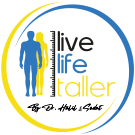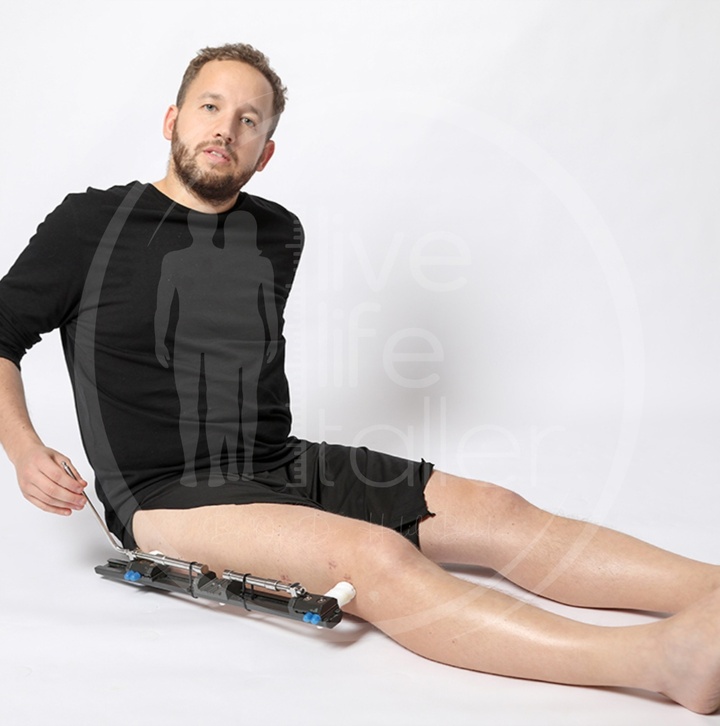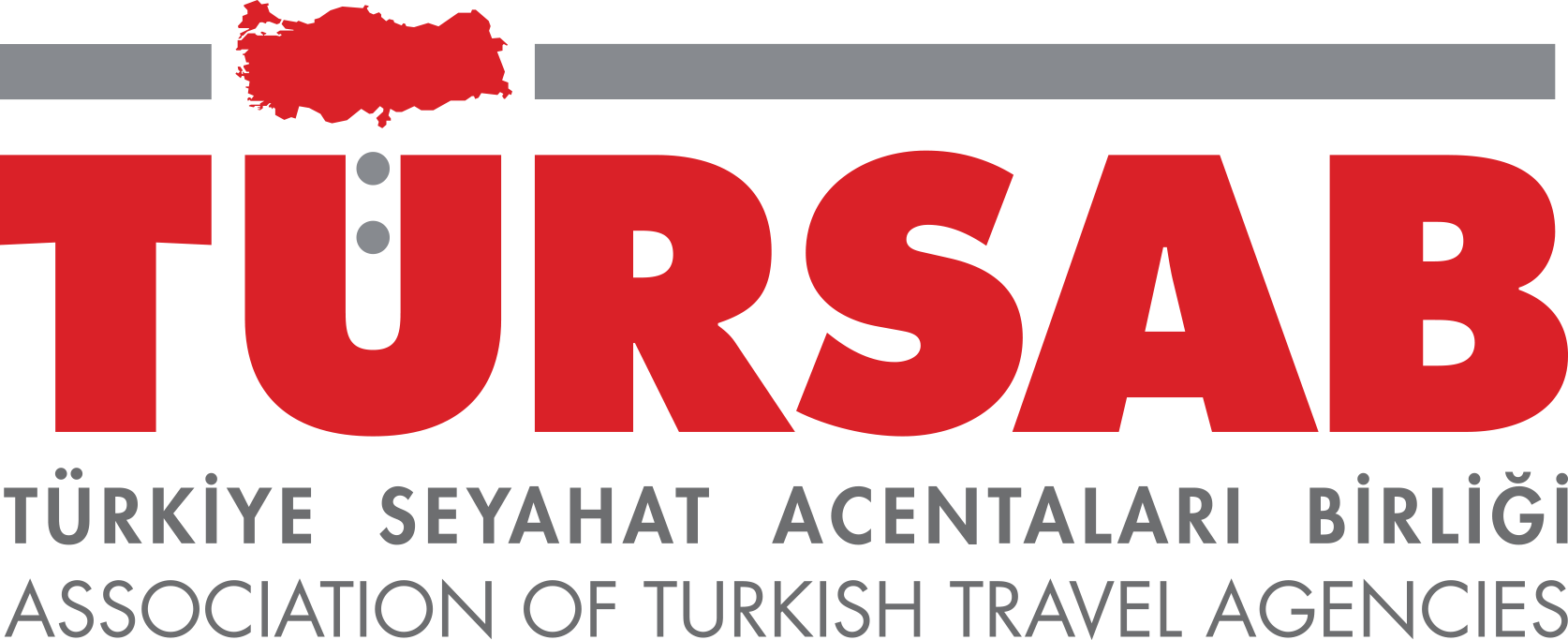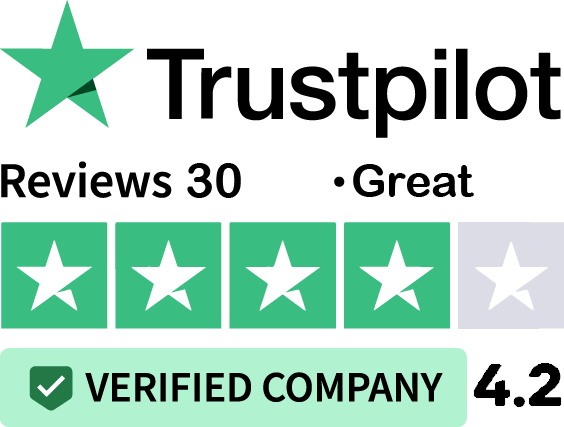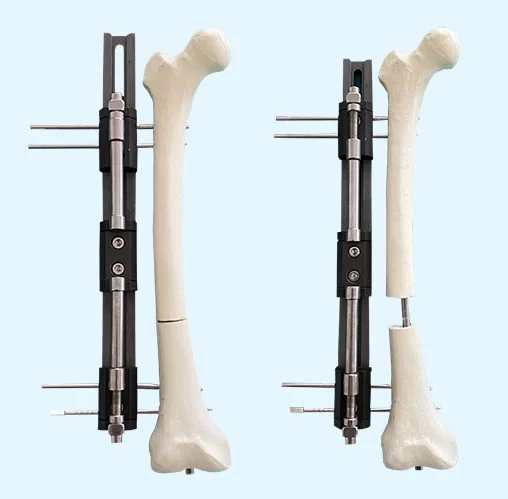
Lengthening Over Nail (LON Method)
Lengthening Over a Nail (LON) is relatively new technique that combines external fixator distraction osteosynthesis with the convenience of intramedullary nail.
What is the LON method?
The LON method (lengthening over nails), also known as external fixator combined with intramedullary nail, is a holding system attached by the skin. This method is used for broken bones and lengthening surgery. The extension is done with external fixators, the patient extends with a special screw every day by 1 mm to – 1.5 mm every 6 hours (4×6 hours), with the screw on the outside of the external fixator by 0.25 mm – to 0.5 mm, so that at the end of the day 1 to 1.5 mm can be reached.
How is LON method surgery performed?
The external fixator is attached to the bone through the skin in LON method surgery. The intramedullary nail (intramedullary screws) is inserted on the femur either through a small skin incision above the hip or below the kneecap. To extend the lower leg, the intramedullary nail is also inserted below the kneecap.
With the external fixator, the thigh and lower leg bones are gently lengthened. The surgery lasts on average between 3 to 5 hours under general anesthesia.
Materials And Technology Used In The Lon Method
The LON method (Lengthening Over Nail) is a well-established approach used in limb lengthening procedures. It combines the use of internal and external fixation devices to support bone lengthening in a controlled and safe way. A metal rod (intramedullary nail) is inserted into the bone, while an external fixator is applied to the outside of the limb. Together, they ensure the bone stays aligned and stable throughout the treatment.
Modern surgical tools and high-quality materials have improved the results of LON method surgery. Stainless steel and titanium are the most commonly used metals because they are strong, biocompatible, and durable. These materials allow the bone to heal correctly while minimizing the risk of complications. Thanks to these innovations, patients experience shorter healing times and better comfort.
Nails And External Fixators In The Lon Method
Nails and external fixators are key components in the LON method. The internal nail provides strength and structure from within the bone, while the external fixator guides the gradual lengthening and keeps the limb secure during the process.
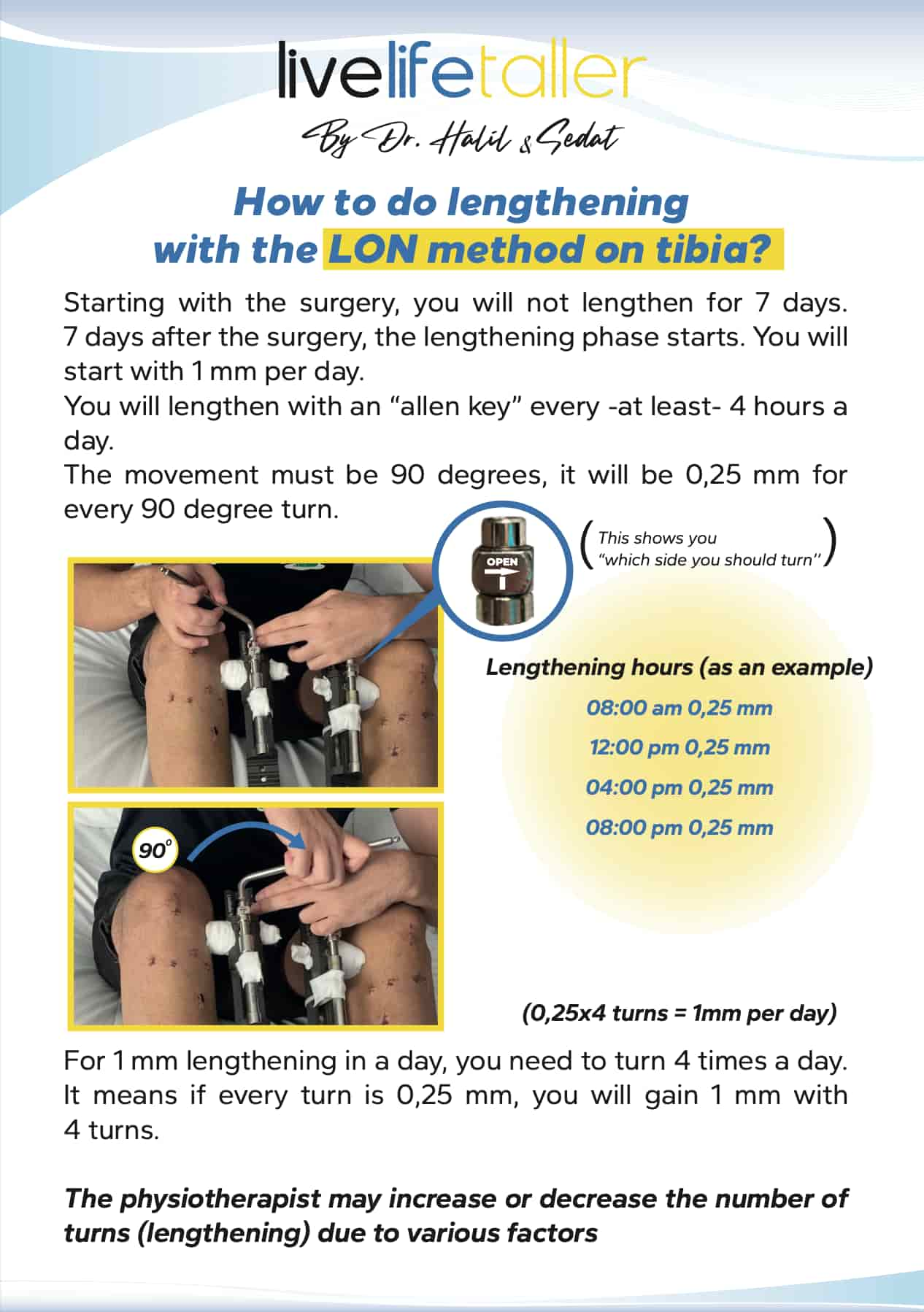
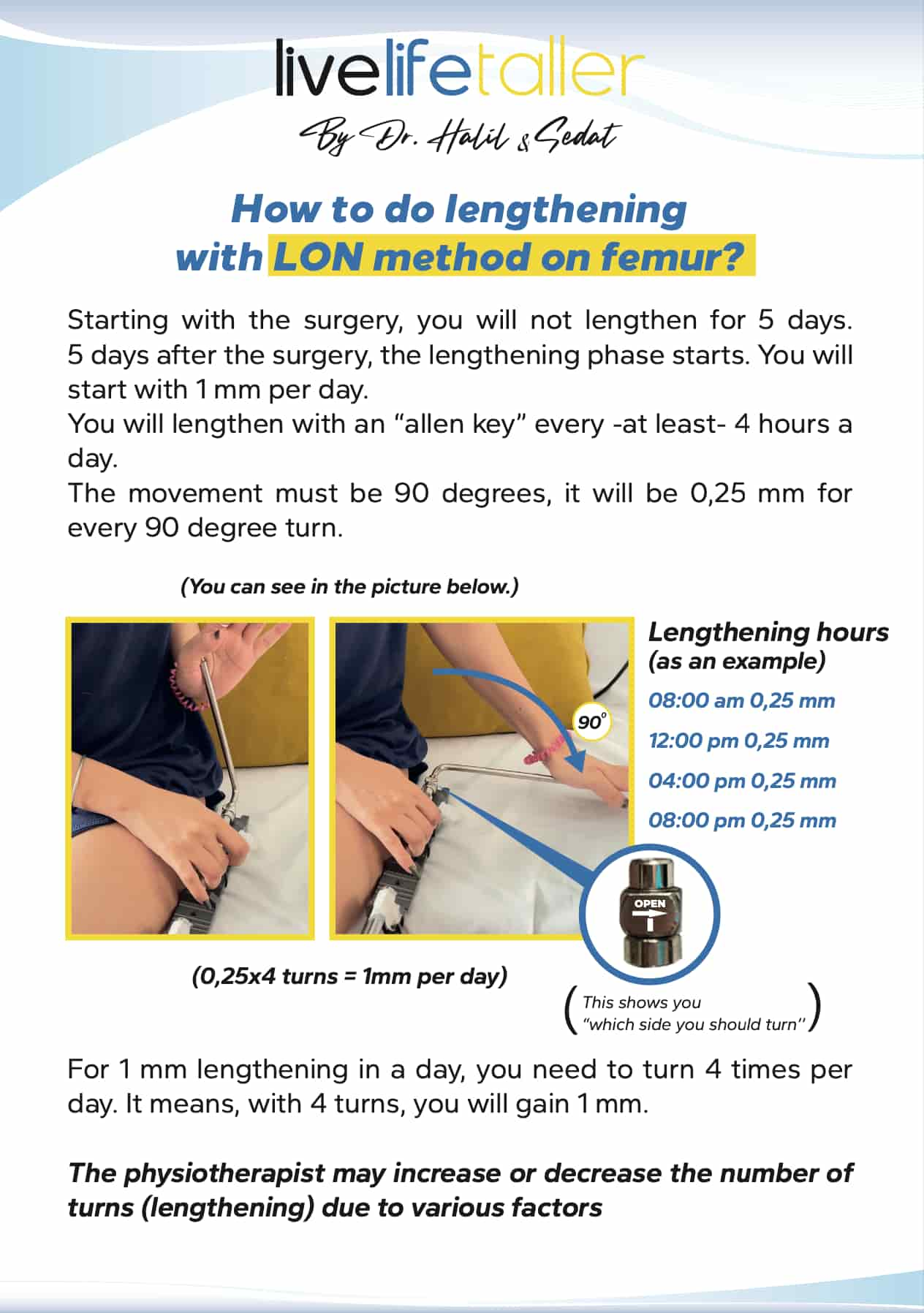
How to lengthen the legs with the LON method?
The lengthening done using a tool called Allen key, which is attached to the screws of the fixators and rotated 90 degrees (equivalent to 0.25 mm).
Every 6 hours (4×6 hours) the external fixator is turned by 0.25 mm – to 0.5 mm with the screw on the outside so that at the end of the day it reaches 1 to 1.5 mm.,
What are the advantages of the LON method?
- Reach the extension in a short time
- Faster healing
- Mobile immediately after the operation
- Achieve more extension thanks to the external fixator
- External fixator is removed immediately after the extension
- Very safe / stable method because fixator and intramedullary nail (intramedullary screws) are combined
- Can be loaded with full weight without walking aids, therefore sports can be done without any problems during treatment.
- In the event of a complication, the external fixator can be adjusted from the outside
- Less risk of infection as minimal screws are attached to the bone
- A very inexpensive alternative to other methods
What are the disadvantages of the Lon method?
- Wound infection
- Limited choice of clothes
- Restricted sleeping position

- Care of the wounds and pins during the extension
- Removal of the intramedullary nail after 100% healing
The LON Method risks
- Anesthesia incidents
- Bleeding during or after surgery
- Non-union
- Early-union
- Wound infections
- Bone infection
How does the process proceed in the LON method?
After the LON method surgery, when the intramedullary nail is inserted to your bone and the external device attached to the bone, the patient stays in the hospital approximately 4-5 days according to their condition.
The lengthening over nail starts 5 days after surgery if you have the femur lengthening. For the tibia lengthening, the patient starts lengthening 7 days after surgery. The start of the lengthening may vary depending on the situation of the patient.
The extension is done with the external fixator, the patient extends with a special screw every day by 1 mm to– 1.5 mm ever 6 hours (4×6 hours), with the screw on the outside of the external fixator by 0.25 mm to – 0.5 mm, so that end of the day 1 to 1.5 mm can be reached.
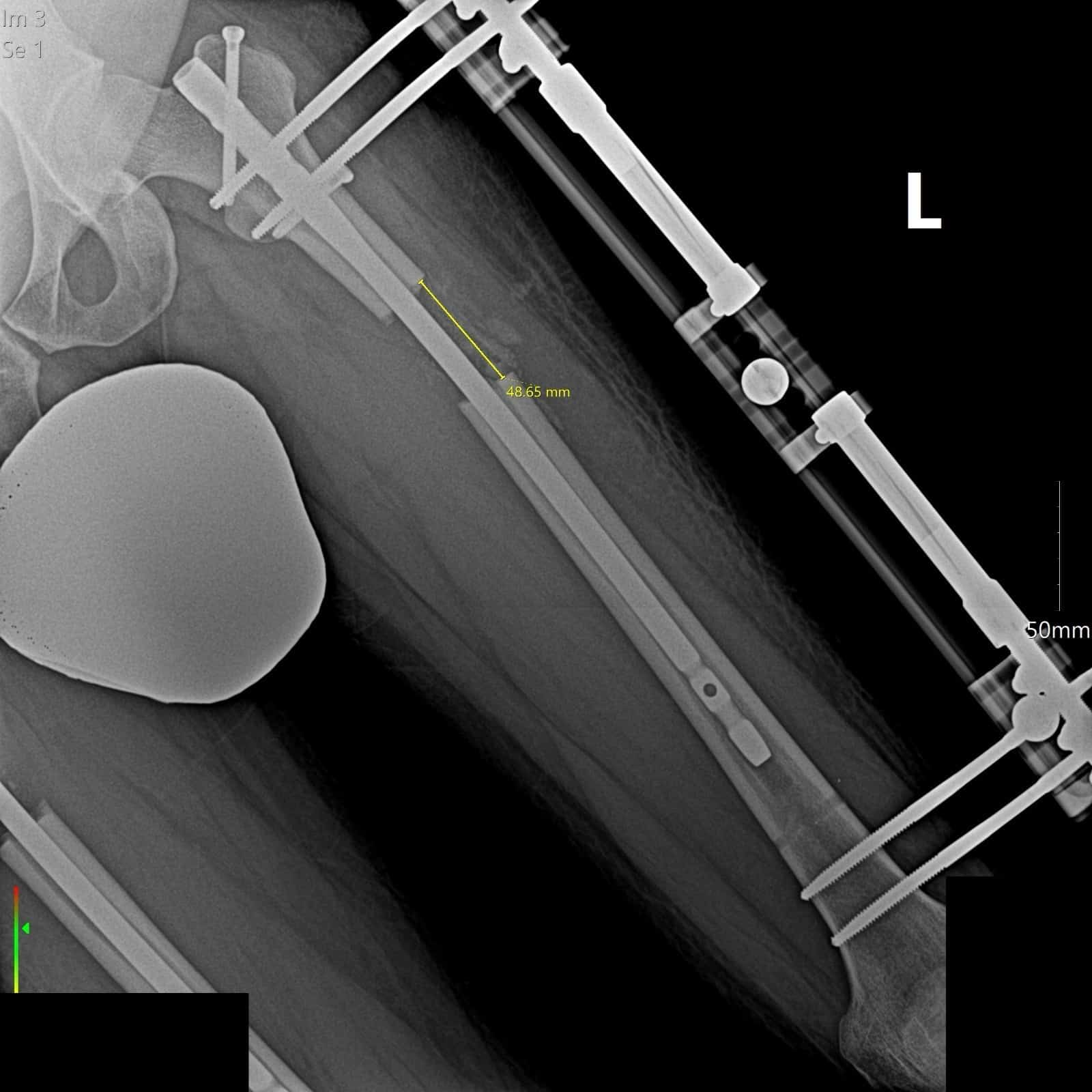
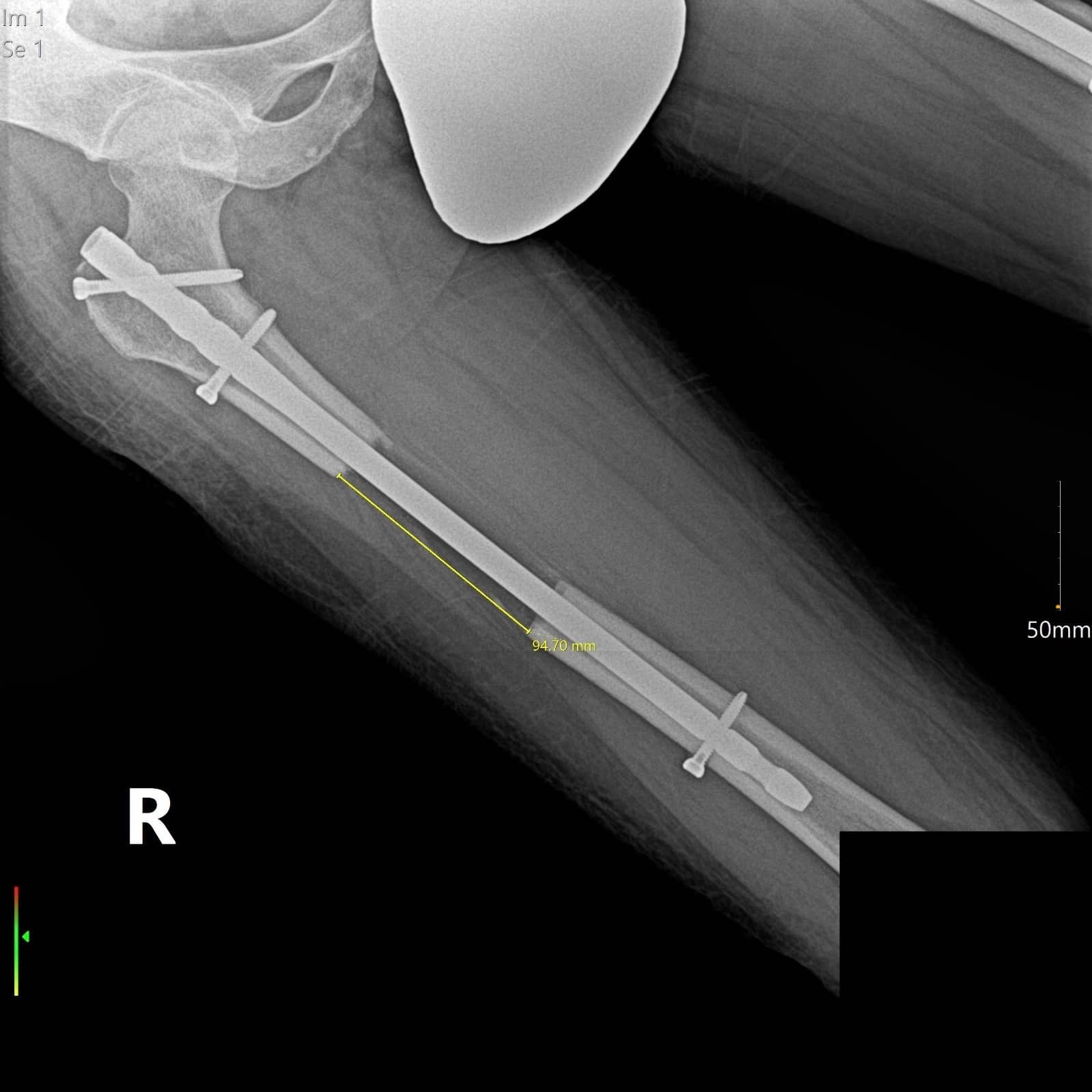
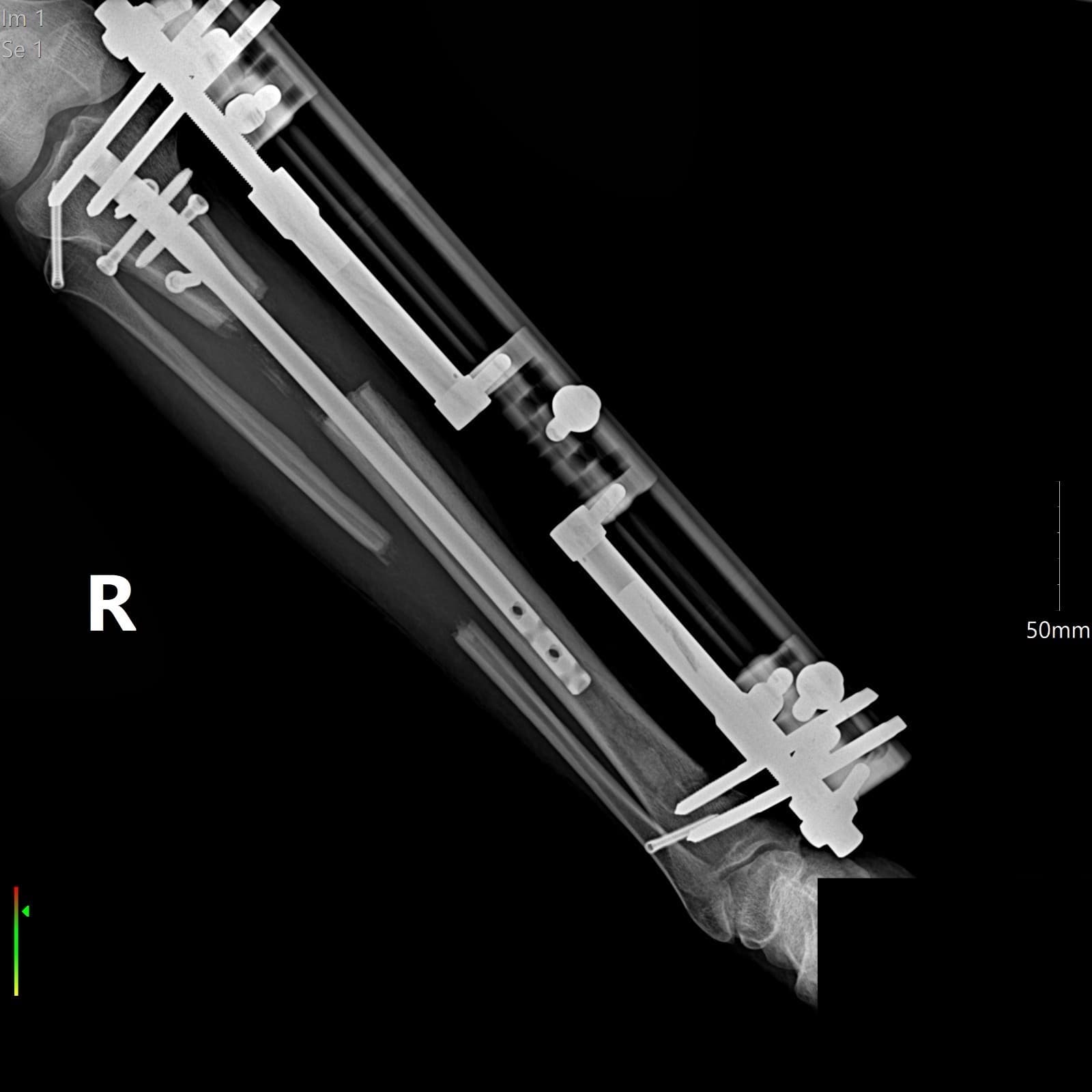
After discharging from the hospital, the lengthening phase starts. Throughout the limb lengthening process, it is essential for the patient to undergo physical therapy and receive expert medical support. For example, with an 8 cm target extension (1 mm per day extension), the patient is finished with the complete extension in 80 days.
The external fixators are removed with a small operation and replaced with an intramedullary nail.
Timeline Of The Lon Method Surgery And Recovery
A typical LON method surgery follows several clear stages. The process begins with a full medical evaluation to check the patient’s health and readiness for the procedure. The surgery itself involves making a controlled cut in the bone (osteotomy), placing the internal nail, and attaching the external fixator. After a short rest period, the bone lengthening begins, usually at a rate of about 1 mm per day.
The recovery timeline depends on how many centimeters the bone is lengthened. On average, the external fixator is removed a few weeks after the desired length is reached, while the internal nail remains until the new bone fully heals. Follow-up visits and X-rays are required during the healing phase to ensure the bone is forming correctly.
Post-Lon Method Rehabilitation And Physical Therapy Process
After LON method surgery, recovery continues with a focused rehabilitation program. This stage is very important to help the patient walk comfortably again and regain full movement. Physical therapy includes exercises for flexibility, strength, and balance. Daily routines are planned to support the healing bone and prevent stiffness in the joints.
Rehabilitation after limb lengthening surgery LON method takes time and patience. Therapists help the patient slowly return to normal activities without putting stress on the healing leg. As the new bone grows and strengthens, regular follow-ups help monitor progress and adjust the therapy plan when needed. A full recovery often depends on how closely patients follow their physical therapy schedule.
Physical Therapy Schedule After Lon Method Surgery
The physical therapy schedule after LON method surgery usually starts a few days after the operation. Patients begin with gentle stretching and walking exercises, then move to strength-building as healing improves. Therapy is often needed several times a week for the first few months.
Real Patient Experiences With The Lon Method
Many patients who have chosen the LON method share positive stories about their limb lengthening journey. The treatment helps people gain height and improve body symmetry, which can boost self-confidence. Patients often speak about the support they received during surgery, lengthening, and recovery.
While every experience is different, most agree that the LON method limb lengthening provides long-lasting results. It’s common to feel some pain or discomfort during the lengthening phase, but with proper care and therapy, the outcome is worth the effort. Real stories show that this method has changed lives for the better.
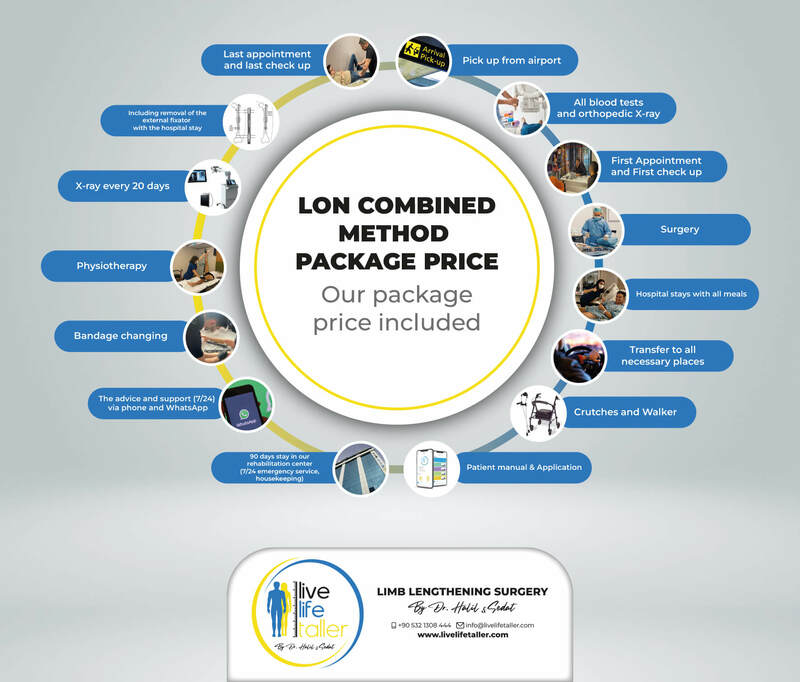
Cost of Limb Lengthening with LON method
The LON method cost is more affordable than the Precice 2 and Fitbone method. One of the reasons for this is the easy access to the material used. Another reason is that unlike the Precice 2 and Fitbone method, LON method scars are a little more.
During the lengthening process, daily lengthening can be performed in a simple way with only an allen key without the need for an extra device.
Lon Method Limb Lengthening Cost Turkey
The LON method limb lengthening cost Turkey is more affordable compared to many countries. Turkey offers experienced surgeons, advanced hospitals, and professional care at a lower price, making it a popular choice for international patients seeking limb lengthening treatment.
The estimated cost for the LON method ranges from 20,000 to 40,000 euros. This price may vary depending on factors such as hospital stay duration, the total lengthening planned, additional medical services, and the length of your post-operative care.
Frequently Asked Questions About the LON Method
How many cm height can be increased with LON method surgery?
The LON method can let the patient lengthen beyond 8 cm as opposed to Precice 2 and Fitbone method for the femur. The patient can lengthen around 8 to 10 cm.
Is LON method surgery painful?
The surgical procedure itself generally doesn’t induce pain as the patient is under general anaesthesia. However, following the LON method surgery, there might be a mild discomfort until the effects of the anaesthesia subside. It’s crucial to note that pain thresholds vary among individuals. Our team will be available at the hospital to ensure that any discomfort is kept to minimum. The discomfort experienced during the lengthening process can be compared to muscles soreness. In the LON method, some patients complain about pain at the pin entry sites as well as skin pain.
Who can have the LON method done?
Limb lengthening surgery may be considered for individuals with no existing health issues. The diseases are uncontrolled diabetes, cancer, bone disorders, skin diseases.
At what age can the LON method be performed?
There is no age limit for limb lengthening surgery as well as limb lengthening LON method surgery. The important thing that can stop you from having the surgery is if you have any health problems.
The procedure for lengthening limbs through surgery is a complex medical intervention that requires careful considerations. One crucial requirement for this procedure is that the patient has completed their growth phase to ensure that the surgery doesn’t interfere with natural growth. Typically, an experienced specialist, an endocrinologist, assessed this through various tests and analyses to determine the growth status.
Moreover, it’s vital that the patient doesn’t have any serious illnesses or health conditions that could increase the risk associated with the procedure. Thorough medical evaluations and assessments are necessary to ensure the patient’s suitability for this operation.
Usually, individuals undergoing limb lengthening surgery fall within the age range of 13 to 65 years. This broad span accommodates younger patients who may require corrections due to growth disorders or other medical reasons, as well as older patients seeking length adjustments for aesthetic or functional purposes.
Overall, limb lengthening surgery demands a comprehensive evaluation of individual’s health to ensure a safe and effective procedure. It’s essential that the surgery is performed by an experienced surgeon within a specialised medical setting to achieve optimal results and facilitate successful rehabilitation.
What is the doctor’s follow-up process after LON method surgery?
After the LON method surgery, the patient starts lengthening approximately 5-7 days later. Following this, physiotherapy sessions commence, accompanied by doctor visits every 2 weeks, and X-Rays taken every 10-15 days. These steps enable the doctor to measure the extent of the lengthening and provide an assessment. Once patients reach their targeted goal, the removal process takes place, initiating the subsequent recovery phase.
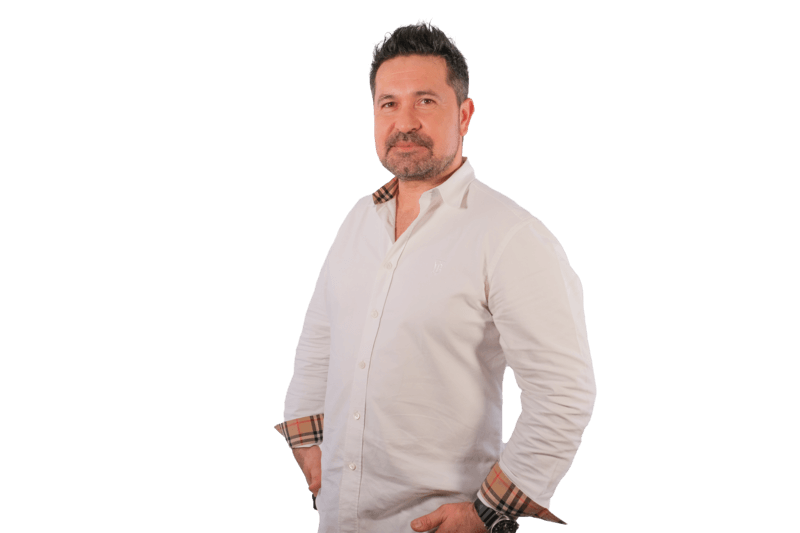
Op. Dr. Halil Buldu
Orthopedic Surgeon and specialist in Limb Lengthening & Deformity Correction with over 14 years of experiences
Author Page